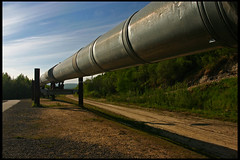 When preparing a new order, you take into account goods that are still in transit (a.k.a. the pipeline), right? Right, so we need not discuss things further.
When preparing a new order, you take into account goods that are still in transit (a.k.a. the pipeline), right? Right, so we need not discuss things further.
Or do we?
In practice, there are a number of issues that surround the pipeline that complicate things and ensure that in reality, we often incorporate incorrect pipeline figures in our calculations.
- Time. When do you expect the goods to arrive? Tomorrow? Next week? In a year? And that date, does it relate to arrival in your transit port, a country away? Or at the airport next door? And how long will clearing and onward transport to your projects take? In the end, the main issue is when the goods will arrive where they are needed, in your programme; all other considerations are important only for the purpose of determining that date. However, in the settings where we work, they are often difficult to predict. An example: some years ago, I was involved in importing a large consignment for an African ministry of health. We felt that we had done our planning quite well, taking normal transit and clearing times into account and adding a buffer based on the normal spread. What we did not know, however, was that the ministry of agriculture had ordered a massive consignment of fertiliser – and when I say “massive”, I mean tens of bulk shiploads, all arriving at more or less the same time. This consignment arrived at the same time as our containers, congesting the port of entry to a point where we could not land the containers for several days, and then struggled for several weeks to find onwards transport capacity. I learned from this the value of growing and maintaining an extensive information network in whichever location you find yourself. If I had talked with some people in the main transport companies, I would soon enough have heard that their capacity was fully booked out.
- Confirmation. You know you ordered 20 boxes of paravenozole, delivery at your warehouse due next week, but did you actually get a confirmation from your supplier? Too often we do not insist on binding timelines, with obvious results; and if we do, we do not enforce them well enough. This is improving, though: I have seen various solutions to this problem. The one I like best is to have ‘order managers’: dedicated staff who take over the management of the order once it has been placed, ensuring that confirmations are received and regularly following up status with the supplier.
- Matching.You know that there are 20 boxes of paravenozole in the next plane to arrive, but… for which project are they? And to cover which order? The supplier of course uses a different system of identifying orders than you do, let alone of article coding. So how can you match this? Obviously, the key here is keeping your paperwork in order, ensuring a clear trail from project order ID, to your order ID, to the suppliers order ID. In reality, this is slightly more complicated than it sounds because we often need to split up orders, and might have on-the-run changes. And of course, we are not talking of one consignment with one type of goods for one project on one order… However, none of this is insurmountable. The most important thing here is discipline: the discipline to document continuously what we do, why we do it, and what are the results – in such a way that we can easily find things back. It does not really matter whether we have an old-fashioned paper-based system or a state-of-the-art ERP system: the principles of documenting and cross-referencing remain the same.
- Units. A small last issue, but one that does trip us up sometimes: did we order twenty boxes of paravenozole, each of 100 doses, 2000 doses in total? Or twenty overboxes, each containing 50 boxes, 100,000 doses in total? Make sure that you document, double-check, and feedback to your projects and your supplier in case you have any doubt.
Taking into account your pipeline figures is your an essential part of order management; and although it may take a lot of work, most of it should be routine activities that can be done at a clerical level. Your pipeline is your connection to your future deliveries, and can give you an invaluable idea of that future for a very small investment.
(Image by rickz.)

{ 0 comments… add one now }